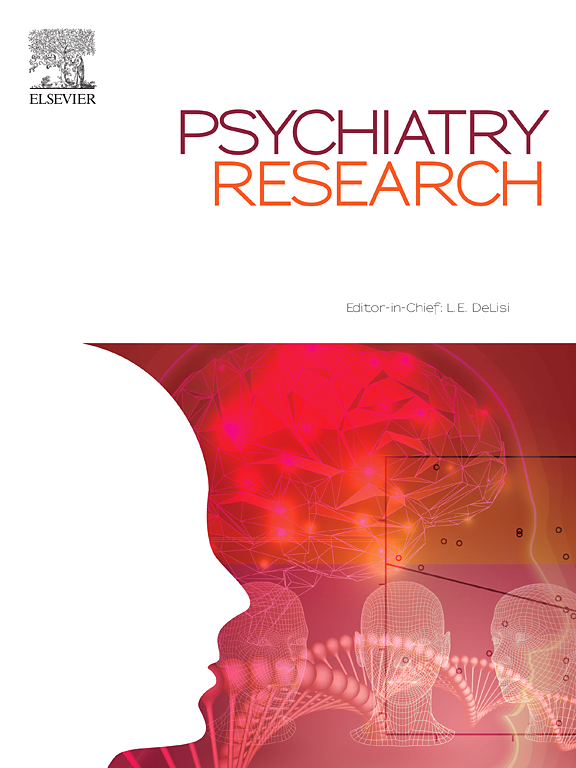Catatonia in autism spectrum disorder: Analysis of clinical characteristics, stressful life events, and validation of the attenuated behavior questionnaire (ABQ)
IF 3.9
2区 医学
Q1 PSYCHIATRY
引用次数: 0
Abstract
Autism spectrum disorder (ASD) and catatonia exhibit overlapping motor and behavioral symptoms; however, catatonia is often underdiagnosed in individuals with ASD. This study evaluates the validity and reliability of the Turkish version of the Attenuated Behavior Questionnaire (ABQ) and explores the clinical characteristics of individuals with ASD and catatonia. The study involved 300 participants with ASD, aged 12–25 years. Parents completed the ABQ, Repetitive Behavior Scale (RBS), and Aberrant Behavior Checklist (ABC), while clinicians evaluated catatonia using DSM-5 criteria, the Bush Francis Catatonia Rating Scale (BFCRS), KANNER Scale, and Childhood Autism Rating Scale (CARS). Regression in social and language skills and stressful life events from the previous six months were also assessed. The mean age of participants was 16.0 years, with 32 (10.7 %) diagnosed with catatonia; among these, 15.3 % experienced regression, and 25.0 % reported stressful life events. The ABQ showed strong validity and reliability (Spearman-Brown coefficient = 0.979), with ROC analysis determining diagnostic (92.5) and screening (39.5) cut-off points. Participants with ASD and catatonia had significantly elevated rates of late regression, impairments in social and language skills, psychiatric comorbidities, and stressful life events, and they scored considerably higher on BFCRS, KANNER, CARS, RBS, and ABC (all p < .05). Our findings highlight high prevalence of catatonia among individuals with ASD and its association with late regression, social and language impairments, psychiatric comorbidities, and stressful life events and underscore the clinical utility of the ABQ in identifying catatonic symptoms in ASD and emphasize the importance of early recognition and intervention.
自闭症谱系障碍中的紧张症:临床特征、应激性生活事件分析及减毒行为问卷(ABQ)的验证
自闭症谱系障碍(ASD)和紧张症表现出重叠的运动和行为症状;然而,紧张症在ASD患者中经常被误诊。本研究评估土耳其版减毒行为问卷(ABQ)的效度和信度,探讨ASD和紧张症患者的临床特征。这项研究涉及300名年龄在12-25岁之间的自闭症患者。家长完成ABQ、重复行为量表(RBS)和异常行为检查表(ABC),临床医生使用DSM-5标准、Bush - Francis紧张症评定量表(BFCRS)、KANNER量表和儿童自闭症评定量表(CARS)评估紧张症。研究人员还评估了前六个月的社交和语言技能以及压力生活事件的退化情况。参与者的平均年龄为16.0岁,其中32人(10.7%)被诊断为紧张症;其中,15.3%的人经历了倒退,25.0%的人报告了有压力的生活事件。ABQ具有较强的效度和信度(Spearman-Brown系数= 0.979),ROC分析确定诊断(92.5)和筛选(39.5)分界点。患有ASD和紧张症的参与者在晚期退化、社交和语言技能障碍、精神合并症和压力生活事件方面的发生率显著升高,并且他们在BFCRS、KANNER、CARS、RBS和ABC上的得分明显更高(p <;. 05)。我们的研究结果强调了紧张症在ASD患者中的高患病率及其与晚期衰退、社交和语言障碍、精神合并症和紧张生活事件的关联,强调了ABQ在识别ASD紧张症症状方面的临床应用,并强调了早期识别和干预的重要性。
本文章由计算机程序翻译,如有差异,请以英文原文为准。
求助全文
约1分钟内获得全文
求助全文
来源期刊

Psychiatry Research
医学-精神病学
CiteScore
17.40
自引率
1.80%
发文量
527
审稿时长
57 days
期刊介绍:
Psychiatry Research offers swift publication of comprehensive research reports and reviews within the field of psychiatry.
The scope of the journal encompasses:
Biochemical, physiological, neuroanatomic, genetic, neurocognitive, and psychosocial determinants of psychiatric disorders.
Diagnostic assessments of psychiatric disorders.
Evaluations that pursue hypotheses about the cause or causes of psychiatric diseases.
Evaluations of pharmacologic and non-pharmacologic psychiatric treatments.
Basic neuroscience studies related to animal or neurochemical models for psychiatric disorders.
Methodological advances, such as instrumentation, clinical scales, and assays directly applicable to psychiatric research.
 求助内容:
求助内容: 应助结果提醒方式:
应助结果提醒方式:


